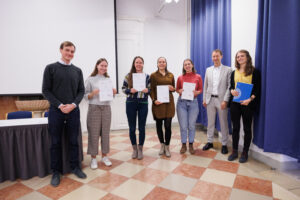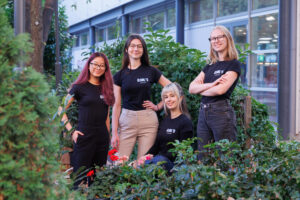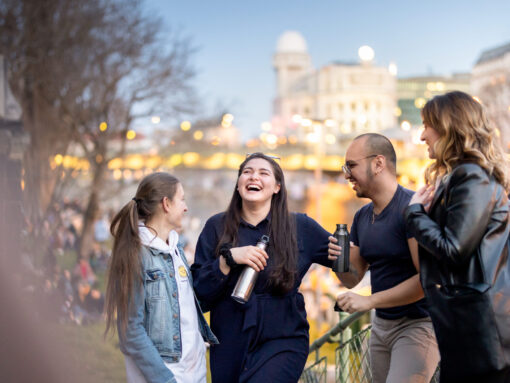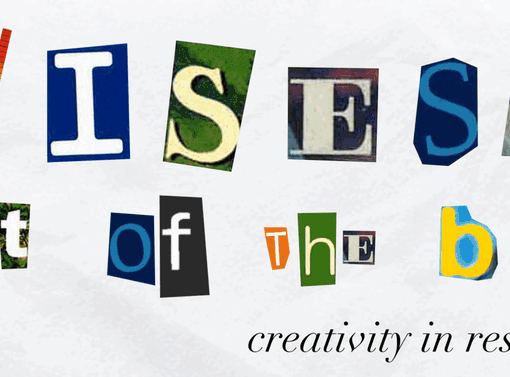Three days, six teams and one big challenge – how to make Vienna more sustainable by providing new digital tools. The Vienna Climate Challenge Hackathon organized by the University of Vienna provided a diverse group of bachelor’s and master’s students, PhD candidates and postdocs with the opportunity to develop their own ideas and pitch them to a jury comprising members of the University, the City of Vienna, and SDG Watch Austria.
What is a hackathon?
What even is a hackathon?
The term originates from the field of computer science and combines the two words “hacking” and “marathon”. Originally, it referred to solving problems by writing code in a very intense but short time span, usually two or three days. The focus lies on developing ideas and quick prototyping instead of perfectly working out all details.
Over the last years, hackathons have evolved in many different directions and do not necessarily require programming skills anymore. The Vienna Climate Challenge explicitly invited participants from all disciplines to work together, learn from each other and generate diverse ideas. Anyone affiliated with the University could register, pitch their idea to the other participants and work on it for the three days at the hackathon.
Project work was complemented with very interesting presentations on a wide range of useful topics, from the challenges Vienna is currently facing (City of Vienna) to quick prototyping without programming skills (UpLeveled), the UN Sustainable Development Goals (SDG Watch Austria) and creating a business plan to support programs for start-ups (Austria Wirtschaftsservice).
After three days of fun and hard work, all project teams got the chance to pitch their ideas and/or prototypes to the jury who then selected two winning teams.
Why attend?
Why attend?
The two winning teams not only received a monetary prize, they also got the chance to discuss their ideas and future collaborations with more representatives from the City of Vienna and pitch their projects to a wider audience.
But what is in it for those who did not win?
Personally, when I registered for the hackathon, I did not think about winning, or even pitching my own idea at all. My main motivation was to learn about and work on a topic I am interested in but currently not working on. Then I spontaneously came up with an idea, pitched it to the group and suddenly had a great team of people working with me on developing that idea – a hackathon is a great opportunity for trying out one’s own ideas and getting feedback from other people.
I am a huge fan of interdisciplinarity, so the hackathon was the perfect environment for me. I really enjoyed meeting many new people, especially from other disciplines, who helped me expand my horizon beyond my field of research and might even be useful contacts for future projects, jobs, etc.
As a researcher, work can be a bit lonely at times, so working in a group was a great experience for me. We split up our work according to our respective skills and interests, but still discussed the main ideas and concepts with the entire team. My team was very interdisciplinary, with our backgrounds covering data science, psychology, communication and business, so we could learn a lot from each other and generated many ideas that each of us would not have come up with individually.
As you can see, there are many great reasons to attend a hackathon – even if you are not really sure how you can contribute in the beginning.
Results
Results
The hackathon resulted in six project ideas:
TEAM 1
„Verkehr findet Stadt “– Connecting Urban Traffic Planners with Citizens
Have you ever wished for a new bike lane in your ‘Grätzl’, but didn’t know who to contact for that? Do you actually know who to contact, but the process seems tedious and not worth the effort? With our communication platform “Verkehr findet Stadt” we solve these issues and let you be part of your Grätzl’s traffic infrastructure.
Including citizens in urban traffic and mobility planning is crucial to actually meet their needs. Building the green infrastructure, they wish for also increases the chances of citizens preferring greener modes of transport over cars. “Verkehr findet Stadt” bridges the communication gap between city and citizens by lowering the threshold for reporting problems, needs and wishes and giving the city the option to react to citizens’ requests.
The platform consists of a website on the city’s and an app on the citizen’s end. With three simple clicks citizens can report their location-based ideas for bike lanes, pedestrian areas and other green mobility infrastructure projects. They can also see other people’s ideas and give them a thumbs up if they agree. The city planners see all these suggestions, together with environmental data from external sources, such as heat, traffic flows and emissions. If they decide to start a new project, they publish information about the project together with questionnaires to gather feedback from the citizens, keeping them in the loop.
While our first prototype concentrates on traffic issues only, the pool of topics can easily be extended to other forms of (green) infrastructure, such as energy supply, making it an important step towards more sustainable Climate Grätzls.
TEAM 2
Climate Change is about to change our cities drastically. Temperatures in the city will rise to unbearable levels in the future. CO2 emissions will have to be reduced drastically. This means cars, which are extreme heat absorbers and CO2 polluters, will have to be reduced dramatically and plants and trees will have to be planted instead.
But how do we get citizens on board with this much needed change? How can we even encourage them to get creative and envision their own future streets?
Vision_Vienna is a smartphone app that lets you “redesign” your street using augmented reality. It works like this: You start the app and point the camera of your smartphone or tablet on the street you want to redesign. On your screen you can then remove objects like cars and replace them with other objects like trees, benches, shrubs, bicycle stands, Grätzloasen, fountains, etc. You can immediately see how your “new” street would look like and save and share your street so that others can see your results as well. The app gives you instant feedback on how your changes would affect temperature, CO2 emissions, maintenance costs and quality of life.
This not only allows you to communicate needed change to citizens but also allows them to get creative themselves in a participatory way.
TEAM 3
Green Hood is a mobile application that helps motivate employees in a company to save energy and resources.
Our application uses various aspects of gamification, such as collecting coins with your in-app team for every task one completes, digital badges for different achievements and a shop where the teams can exchange their coins for rewards.
Our plan is to work with various charities and companies to create prizes for our exchange shop that would give back to organizations working to fight climate change.
With our app we strive to create better habits in the workplace with the intention that these good habits will also trickle down into the employees private lives.
The coding club called “G:URL*s” for women and non-binary people is searching for new members and is open for collaborations if interested. Instagram: @gurls_coding_club or email: codingclubvienna@gmail.com.
TEAM 5
NeighbourHood is a non profit app that aims at digitally assisting the local free exchange of (used) items (and services) and thus reduce our city’s ecological footprint. We help people to get rid of stuff that went out of use and simultaneously provide others with the stuff they want for free. This clever and easy way of reusing things reduces not only CO2 emissions, but all of the human impact on the ecosystem including issues like mining and waste.
Another aspect of our mission is ensuring a safe transition of goods. If a neighbour requests it, things can be exchanged by depositing them in local locker boxes, the ‘NeighbourHood’ stations. In this way Neighbourhood is also empowering people who feel insecure meeting unknown persons. Of course, the lockers can also be useful if you and your exchange partner don’t manage to find a common date to meet.
On the long run, the app will create a local community with additional features like a forum and a news channel, and maybe other functionalities that turn out to be wanted by the community.
And now?
And now?
Now you might wonder – this sounds all great and fun for the participants, but why would the University invest money and effort to organize such an event? As described before, a hackathon is a unique opportunity to bring together people from different disciplines to create ideas and work together on one topic. While interdisciplinary work may be difficult, it usually results in much broader ideas than by staying in one field of expertise. Generating new ideas and connecting disciplines is one of a university’s key interests.
Some of the ideas might also result in future research projects and/or businesses, which benefits both the University and the City of Vienna. Both winning teams are currently in contact with representatives from the City of Vienna, discussing the next steps of their projects – so you may soon read about a new start-up on this blog.
If you want to attend the next hackathon make sure to follow us on Instagram to not miss the next application deadline!



